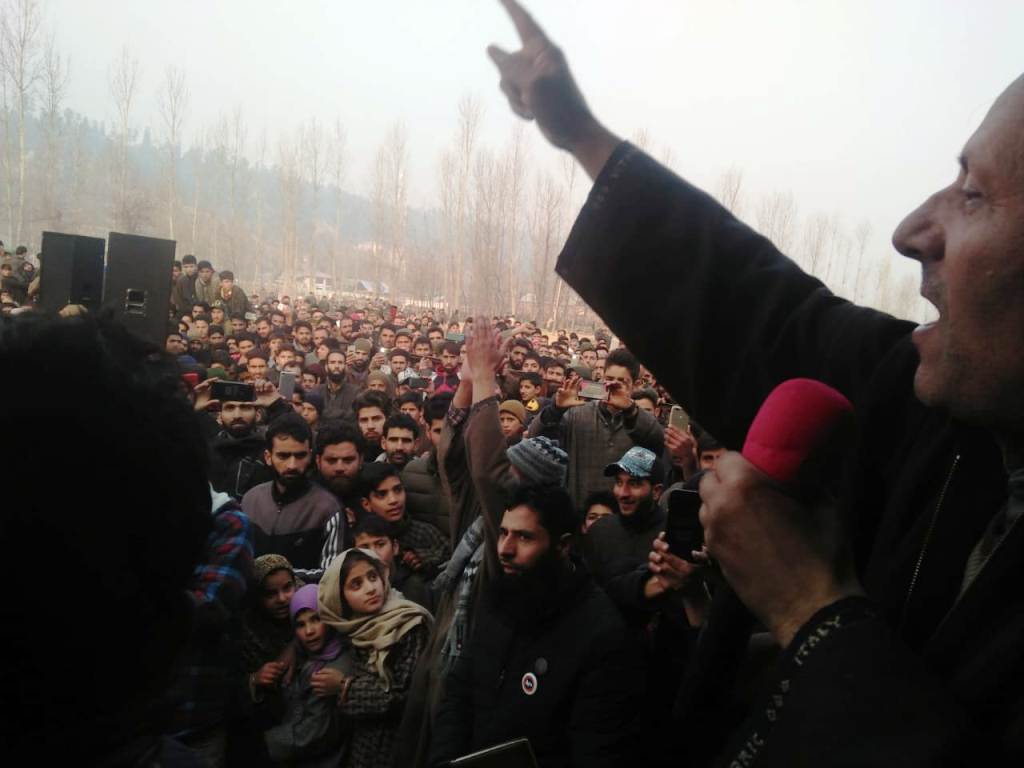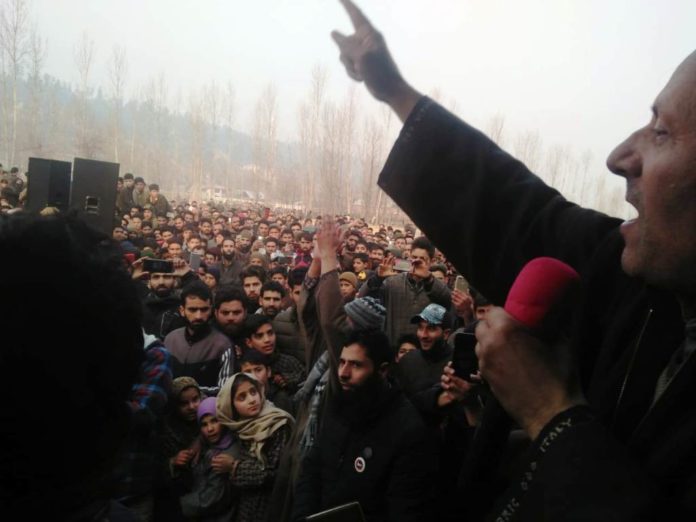by Faroz Ahamd Lone
With 15 candidates engaged in a fierce contest, it remains to be seen if Engineer Rashid’s brother can retain the Langate assembly seat within family fold for the third term, writes
= Langate, almost two-hour’s drive from Srinagar, is nestled in the northern reaches of Kashmir. It emerged one of the major hotspots in the Jammu and Kashmir’s 2024 assembly elections because of the Engineer Rashid, who emerged victorious in the Lok Sabha elections because of an aggressive and no-promise campaign by his sons.
Political Landscape
There are 15 contenders for the seat in the election for which the electors polled on October1, 2024, in the last of the three phase assembly election. . The competition is fierce, particularly among key candidates. Engineer Rashid’s brother, Khursheed Ahmad Sheikh, faces stiff competition from Irfan Sultan (Panditpuri) of Jammu and Kashmir People Conference, Syed Ghulam Nabi Bukhari of JKPDP, and Irshad Hussain Ganaie of Congress.
The seriousness with which these contestants approach election campaigning and related efforts makes predicting the outcome challenging. It is premature to draw conclusions based solely on the campaigning.

Historically, the Jammu and Kashmir National Conference has dominated this seat since its 1977 establishment, winning it a record five times. Jammu and Kashmir Peoples Democratic Party has held the seat only once, in the 1999 by-polls, when Mohammad Sultan Ganai (Panditpuri) emerged victorious.
JKNC won the seat for four consecutive terms. Mohammad Sultan Ganai (Panditpuri) secured the seat in 1977, followed by Abdul Ahad Wani, who holds the distinction of being the constituency’s sole three-time consecutive winner (1983, 1987, and 1996).
After JKPDP wrested control in the 1999 by-polls, JKNC’s Sharief-ud-DinShariq reclaimed the seat in the 2002 polls.
The Langate constituency’s recent history has been shaped by the influence of Engineer Rashid. His vocal stance on various issues has been a defining characteristic of his political career. Rashid’s unique protest style against the local government resonated with the valley’s residents, expanding his following and influence.
In the 2008 elections, Engineer Rashid gave up his government job, contested as an independent candidate and secured the seat. Rashid garnered 7,964 votes, accounting for 21.86 per cent of the total, narrowly defeating JKPDP’s Panditpuri, who polled 7,754votes (21.29 per cent). The margin of victory was a mere 210 votes.
Rashid’s success continued in the 2014 elections, where he contested under the banner of his Awami Itihad Party. He secured 18,172 votes, representing 35.49 per cent of the total, and won the seat for the second time. JKPDP candidate Ghulam Nabi Ganai polled 15,667 votes (30.60 per cent), while JKPC’s Mohammad Abdullah Mir secured 10,015votes (19.56 per cent). Independent candidate Irshad Hussain Ganaie finished fourth with 1,819votes (3.55 per cent). The total votes cast were 51,204, reflecting a 72.52 per cent turnout.
The electoral landscape in Langate heated up, this season, with 15 contenders vying for the top spot. Notable candidates include Abdul Hameed Teli from the Bharatiya Sampuran Krantikari Party, Irfan Sultan Pandithpuri from the Jammu and Kashmir People Conference, and Irshad Hussain Ganaie from the Indian National Congress. Also in the running are Syed Ghulam Nabi Bukhari from the Jammu and Kashmir People’s Democratic Party, and Khursheed Ahmad Shiekh, who is running as an independent.
Other independent candidates include Ghulam Qadir Shah, Junaid Jawaid Mir, Kalimullah Lone, Khursheeda Bagam, Mohammad Muzaffar Sheikh, Mohammad Sultan Magray, and Shabir Ahmad Shah. Rounding out the field are Irfan Bashir Malik from the Rashtriya Lok Dal, Mohammad Ashraf Gojri from the Bhim Sena, and Mohammad Munawar Khawaja from the Jammu and Kashmir Apni Party.
Demography
A substantial voter base of 120211 individuals is poised to participate, a figure that encapsulates the district’s diverse demographic tapestry. Among these, male voters number 60,056, constituting 49.95 per cent of the total electorate, a slight underrepresentation compared to their female counterparts. Female voters, on the other hand, account for 60,152, or 50.03 per cent of the total votes, edging out male voters by a margin of 96. Furthermore, the constituency has recorded three transgender voters, a notable inclusion in the electoral process.
Spread across Langate are 143 polling station facilities, designed to cater to both rural and urban voters. Of these, 133 polling stations are designated for rural areas, with the remaining 10 situated in urban locales. This distribution reflects the constituency’s predominantly rural character while ensuring accessibility for all voters.
The voter demographic is remarkably varied, encompassing individuals from different communities and castes. Historical electoral data suggests that, despite the diversity in backgrounds and political allegiances, the voting process typically unfolds peacefully. This tradition of tranquil voting underscores the constituency’s commitment to democratic values, where the exercise of the franchise is carried out with respect and mutual tolerance, regardless of differing ideologies, party affiliations, or candidate preferences.
Geography
Located approximately 70 kilometres from Srinagar, the capital city of Jammu and Kashmir, the Langate assembly constituency is connected by road, facilitating accessibility. In the Kupwara district, the Langate constituency is bounded by Kralgund Tehsil to the south and Handwara to the north. Nearby towns include Watergam, Sopore, and Baramullah.
In terms of elevation, Langate sits at an average height of about 5,300 feet above sea level. The region experiences a notable shift in climate between summer and winter. During the summer months, the temperature is temperate, whereas winters bring severe cold. August typically marks the hottest month, while January is the coldest.
Challenges and Issues
For voters in Langate, Jammu and Kashmir, everyday life is fraught with numerous obstacles. The constituency grapples with fundamental issues on infrastructure, essential services, and reliable transportation. Many villages struggle with poorly maintained roads, irregular electricity supply, and inconsistent access to clean water, rendering daily existence a challenge.
The inadequacy of healthcare facilities exacerbates these difficulties. Medical centres lack essential equipment, and the scarcity of qualified medical professionals compounds the problem. Similarly, schools face significant infrastructure deficiencies and a shortage of trained educators, undermining the quality of education.
Unemployment poses a significant dilemma, particularly for young people. Limited economic opportunities beyond agriculture leave many without prospects. Even agriculture, the mainstay of the local economy, faces hurdles due to inadequate infrastructure and unpredictable market fluctuations.
A pervasive sense of political disenchantment also pervades the region. Voters feel neglected by successive governments, fostering alienation and disillusionment with the political process. Proximity to the Line of Control introduces security concerns, further destabilizing the area.
Moreover, environmental degradation has severe consequences. Deforestation and erratic weather patterns, driven by climate change, adversely impact agriculture and livelihoods. Despite being represented by prominent figures, including Engineer Rashid, voters often perceive unfulfilled promises of development, leaving the region underrepresented in substantial ways.
Economic Landscape
The Langate constituency’s economy is rooted in agriculture, with the majority of its population engaged in farming, cattle rearing, and associated activities. Traditional crops such as rice, maize, and apples form the foundation of the agricultural sector, providing sustenance for numerous families through subsistence farming. However, the sector’s potential remains untapped due to the lack of modern agricultural infrastructure and limited access to advanced farming techniques.
Supplementary income sources for many households come from cattle rearing and dairy farming. Furthermore, manual labour, encompassing construction work and dailywage jobs, supports a segment of the population, particularly those without land ownership.
The scarcity of industrial development within Langate severely restricts employment opportunities beyond agriculture. This limitation disproportionately affects young people, resulting in substantial unemployment. Consequently, many youths seek opportunities outside the region or rely on seasonal work to make ends meet.


